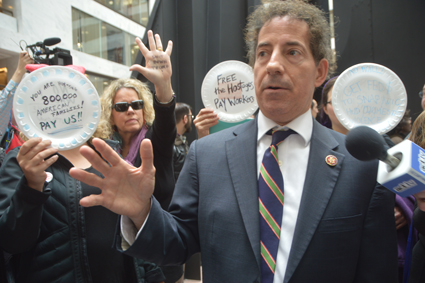For 33 minutes on Wednesday, hundreds of furloughed federal employees and their supporters stood in silence in the large atrium of the Hart Senate Office Building in Washington, D. C. They marked a minute for each day of the extended government shutdown that has broken government services, has hurt hundreds of thousands of federal workers hungry for their paychecks, has demoralized workers, and has crippled federal science agencies.
When they broke the silence, the furloughed employees and their union representatives broke into chants, including “Hey hey, ho ho, this shutdown has got to go!”
The Shutdown “Basically Has Shut Down Science”
The shutdown over a demand by President Donald Trump that Congress approve funds for a southern border wall “basically has shut down science,” J. David Cox, national president of the American Federation of Government Employees (AFGE), told Eos at the protest. “But I guess if you’re a president who doesn’t believe in science, you would like to shut science down.”
“My science is at a complete standstill.”
He called for President Trump and Congress to reopen the government. AFGE, the largest federal employee union, represents employees at NASA, the National Oceanic and Atmospheric Administration (NOAA), the U.S. Environmental Protection Agency (EPA), and other federal agencies. AFGE was one of a number of unions hosting the protest.
Many of the furloughed workers held up disposable dinner plates with handwritten pleas. Jane Rigby, an astrophysicist at NASA Goddard Space Flight Center (GSFC) in Greenbelt, Md., held up a plate reading, “Furloughed scientist ready to explore space again for the nation.”
“My science is at a complete standstill,” Rigby, who normally works on data from the Hubble Space Telescope and NASA’s other large telescopes, told Eos. Instead, she said, “I have been repairing drywall and hanging some shelves and cleaning out clutter in my basement.”
Rigby said that the unintended consequence of the shutdown is that it will be harder to recruit the next generation of scientists and engineers to NASA and other federal science agencies. “We have to go back, when this is all over, and try to recruit civic-minded, hardworking, amazing people to come do science in the public interest,” she said. “And why would they want to do this to themselves when there are other options in industry and academia? Why would they want to do this to themselves when this [government] is not a trustworthy employer?”
The shutdown sends a message that “Congress doesn’t seem to care about science,” Kevin Horgan, an electrical engineer at GSFC, told Eos. “There are studies that go on for years and years that require constant data sets that are being jeopardized,” said Horgan, who held a sign reading, “When it comes to Congress, failure is always an option. Let NASA work! End the shutdown!”
Heartbroken, Frustrated, and Annoyed by the Shutdown

Catherine Tunis, who works in EPA’s Office of Enforcement and Compliance Assurance, held up a plate reading, “Public service is a public trust.”
“I am just heartbroken that we are not able to be there to protect the American public and to protect the planet,” Tunis, who has worked at EPA for 32 years, told Eos. “I feel like there is work that needs to be done, that I should be doing it, and something is holding me back. It’s like somebody is drowning and you’re not allowed to go in and help them. It’s just so frustrating and annoying.”
Katie Renshaw, an attorney with NOAA, held up a plate reading, “Let us work.” The message this shutdown is sending about federal science is “that we are not important, that our contributions are not valuable,” Renshaw told Eos. “That’s a terrible message.”
An Attack on the Federal Workforce
“This shutdown is part of more than 2 years of attacks on the federal workforce by Donald Trump,” which began when Trump imposed a temporary federal hiring freeze in 2017, Rep. Jamie Raskin (D-Md.) told Eos at the protest.

Raskin said that with this coming Friday marking the second paycheck period when many workers will not get paid, hundreds of federal scientists who live in his congressional district “are demoralized and frustrated and terrified by the chaos that is emanating from the White House. It’s just a very scary thing for people who have devoted their careers to public service, to doing science, to doing research about climate change, about food safety, about E. coli, about Salmonella, and suddenly, they are sent home from work or they are told they’ve got to report to work and not get paid.”
“We were in the forefront of world leadership for dealing with climate change, which is an international crisis and an emergency for all of us, and instead, he’s been waging war on federal workers: scientists and researchers who are just trying to do their jobs,” Raskin said about Trump. “The government shutdown is all part of a plan of demobilizing democracy, demoralizing the federal workforce, and isolating us from the rest of the world.”
—Randy Showstack (@RandyShowstack), Staff Writer
Citation:
Showstack, R. (2019), Furloughed federal workers protest extended shutdown, Eos, 100, https://doi.org/10.1029/2019EO114537. Published on 24 January 2019.
Text © 2019. AGU. CC BY-NC-ND 3.0
Except where otherwise noted, images are subject to copyright. Any reuse without express permission from the copyright owner is prohibited.

